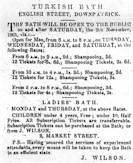Downpatrick: 15 English Street

| Turkish Baths | |
| 1861 | Turkish Baths Turkish baths opened 9 November |
| 1863 | Turkish Baths It is not known when the baths closed |
| Turkish Baths | |
| 1861 | Turkish Baths Turkish baths opened 9 November |
| 1863 | Turkish Baths It is not known when the baths closed |
Little is known about these Turkish baths beyond the first few months after their opening. There is even some confusion about who owned the establishment. There are three possible names, but none is clearly indicated as proprietor. The most likely owner would seem to be a Mr J Wilson whose name appears at the foot of an advertisement in the Downpatrick Recorder1 and in editorial comment elsewhere in the paper.2
The other possibility is Jane Ruthven. She is entered in the local valuation register for 1863 as being the occupier of the Turkish bath and the office behind, for which the rateable value is given as £5 per annum.3 Additionally, there seems to have been a Mr Ruthven entered in the earlier record for 1861.
But whoever actually owned the bath, s/he could hardly have complained at the glowing editorial comment in the local paper.
We are really going fast ahead in Downpatrick, for we venture to say that in the three kingdoms there is not another place of the same size has so far advanced in the arts of civilization and luxury as to be able to boast the possession of a veritable Turkish bath.2
 From the advertisement announcing the forthcoming opening of the bath on 9 November 1861 we know that there were three classes of bather, differentiated only by the time of the day they were admitted. The prices of single tickets were 1/3d between 10.00 am and 4.00 pm, 9d between 6.00 and 8.00 in the morning, and 6d between 5.00 and 8.00 in the evening.
From the advertisement announcing the forthcoming opening of the bath on 9 November 1861 we know that there were three classes of bather, differentiated only by the time of the day they were admitted. The prices of single tickets were 1/3d between 10.00 am and 4.00 pm, 9d between 6.00 and 8.00 in the morning, and 6d between 5.00 and 8.00 in the evening.
Batches of tickets bought a dozen at a time brought a small reduction and were available at 12/-, 6/6d, and 4/-, while shampoos were charged extra at 3/-, 2/6d, and 2/- each.
Unusually, children under ten years old were admitted in each class at half price while children under four were even admitted free, presumably on the theory that a Turkish bath taken as a child makes for another client when the child becomes an adult.
We do not know, of course, how many children were able to take advantage of being allowed in, nor whether they enjoyed it. Certainly some have later written about how they enjoyed such an experience elsewhere; others have told how they were taken regularly by a mother or father and hated it every time.
The bath was closed on Sundays and reserved for women bathers on Mondays and Thursdays. It was reported that the bath was already being 'liberally patronised by ladies as well as gentlemen' though this may merely have been pour encourager les autres.4
The facilities seem to have been made available in stages because, just a couple of months after the opening, the Recorder noted that 'the enterprising lessee of this bath' has built a new 24ftx12ft cooling-room with separate curtained changing cubicles.5
The Recorder continued for several months giving editorial support to the baths, no doubt in return for their advertisements, and on occasion reprinted half-column quotations from the writings of Erasmus Wilson and Sir John Fife, those well-known stalwarts of Turkish bath publicity.
This page last revised and enlarged 27 January 2019
This account should be treated as work in progress. Further research is needed to find out about how the baths were used, and how long they survived.
David McKry and Mary Rice at Downpatrick Library